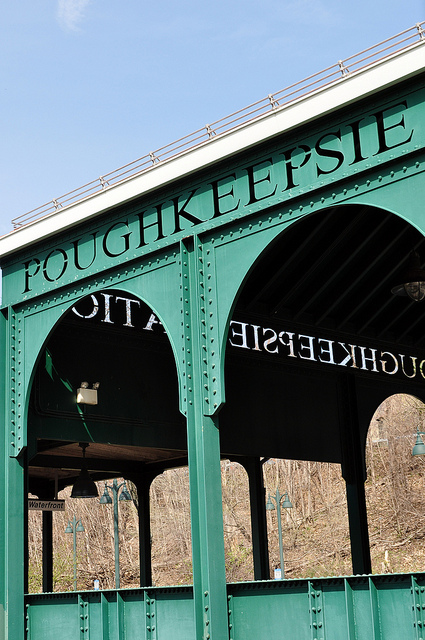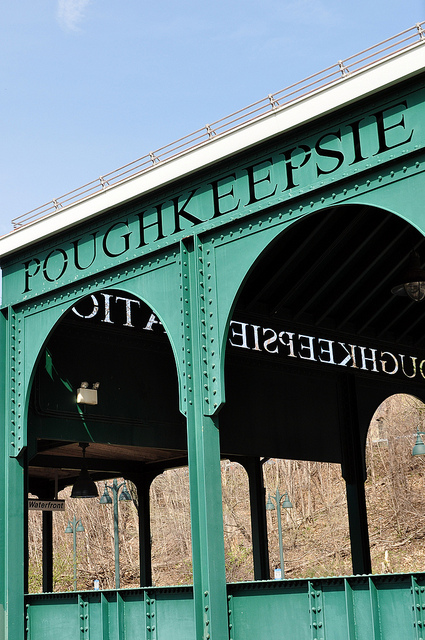 Photo: duluoz cats
Photo: duluoz cats
Cross-posted from The Last Word on Nothing.
A few years ago, I interviewed author and social critic James Kunstler about his novel World Made By Hand, his latest portrayal of a post-peak oil future. Kunstler, as one might expect, had plenty of complaints — about suburbs, Cheez Doodles, Walmart, the American road trip. But when I mentioned that I’d grown up in the Hudson River town of Poughkeepsie, N.Y., he perked up.
“Oh!” he said, sounding as if he’d almost cracked a smile.
People from Poughkeepsie are not, to say the least, used to this kind of reaction. Depending on your generation, you may know my hometown from Gene Hackman’s “Pickin’ your feet in Poughkeepsie” rant in The French Connection; from The Lemonheads song; or from the Friends episode “The One with the Girl from Poughkeepsie” (“How great can she be if she’s from Poughkeepsie?”).
If you know Poughkeepsie at all, chances are you don’t ache to return. The name is Wappinger for “the reed-covered lodge by the little-water place,” though a friend of mine translates it as “place of many strip malls.” Poughkeepsie once made a decent living making hats, brewing beer, and shipping stuff up and down the Hudson, but those glory days are long over. (One of our most successful industries was whale rendering.) With a chronically lackluster downtown and boring ‘burbs, we have neither urban sophistication nor rural charm. As Hudson Valley folkie Bill Ring puts it, “It’s bigger than a village, but it ain’t quite a city/ and it’s not a place a lot of folks are itching to go.” I love a lot of people in Poughkeepsie, but honestly, I prefer to meet them elsewhere.
Kunstler — clearly an incurable contrarian — likes Poughkeepsie. He lives in the Hudson Valley himself, in a far cuter but similarly sized town, and he predicts that such neither-village-nor-city places will one day be just right. “We’ll see people moving to places that are scaled appropriately to our energy diet,” he said — towns small enough to walk across, but big enough to pool their resources for, say, a hydropower plant. And with good farmland on one side and a great big river on the other, Poughkeepsie is ideally placed for local food production and carbon-free transportation. “Towns like Poughkeepsie are at their nadir now,” he conceded, “but they have a lot of virtues that are going to become apparent in the years ahead.”
I don’t necessarily buy Kunstler’s vision of the future, but years of covering climate change have given me the chance to contemplate a lot of grim scenarios. And I had to admit — with a silent groan — that in a hotter, droughtier, less climatically stable world, my current home on the edge of the Colorado Plateau wouldn’t be such a good bet. Poughkeepsie would.
 The Poughkeepsie railroad bridge has been restored as a pedestrian and bike path.Photo: Russ Nelson
The Poughkeepsie railroad bridge has been restored as a pedestrian and bike path.Photo: Russ Nelson
Last fall, while visiting family, I walked across the Poughkeepsie railroad bridge for the first time in my life. Built in 1888, it was damaged in a fire and shut down in 1974, and all through my childhood its ugly black steel skeleton loomed above the river. Two years ago, thanks to local fundraising heroics, it reopened as a busy pedestrian and bike trail, giving Poughkeepsie its first real vantage point on the Hudson.
I stood in the middle of the bridge and looked east toward my hometown, which appears just about as dingy from above as it does at street level. Then I looked down the river toward Manhattan, down the mile-wide channel that once fed this town — and, if Kunstler is right, will one day do so again. The fall foliage glowed on the riverbank bluffs, and hundreds of feet below my toes, in the sweet, salty water of the Hudson estuary, gravity fought the tides.
It was almost enough to charm a prodigal daughter.


